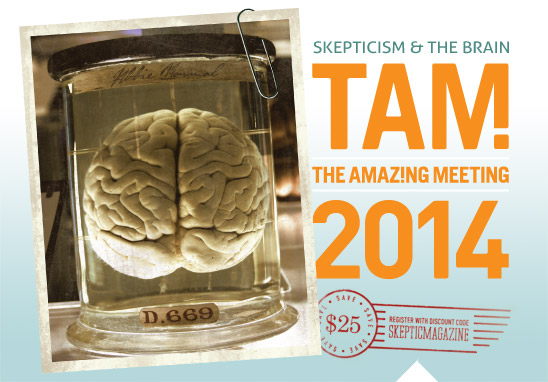In this week’s eSkeptic:
- MonsterTalk: A Tiger by the Tale
- Feature: Gimme That New-Time Religion!
- Distinguished Science Lecture: Dr. Carol Tavris — Mistakes Were Made (But Not By Me): Why We Justify Foolish Beliefs, Bad Decisions, and Hurtful Acts
- The Amazing Meeting 2014: July 10–13, South Point Casino, Las Vegas
- Our Next Geology Tour: Grand Canyon, Zion & Bryce (Jun. 13–20, 2014)


Get the MonsterTalk Podcast App (presented by Skeptic Magazine) and enjoy the science show about monsters on your handheld devices! Available for iOS, Android, and Windows 8 devices. Subscribe to MonsterTalk for free on iTunes. Follow the RSS feed.
MonsterTalk # 81
A Tiger by the Tale
Are mysterious large cats killing livestock and stalking the wilds of Australia? Dr. David Waldron returns to MonsterTalk to discuss his research on alien big cats down under: Snarls from the Tea-Tree: Big Cat Folklore, co-written with Simon Townsend.
David Waldron and Simon Townsend describe the history and evidence for strange misplaced large cats reported in Australia. Farm animals are being killed — but what is the culprit? Zoo escapees? Unknown native cats? Giant feral cats? From folklore to fact, Snarls from the Tea Tree gives a meticulous historical timeline of reports of these animals. In cryptozoology, these kinds of reports are often called “Alien Big Cats” or “ABCs.” Waldron was previously on MonsterTalk to discuss black dog legends of England.

About this week’s eSkeptic
In this week’s eSkeptic, Donald Prothero reviews Karen Stollznow’s book, God Bless America: Strange and Unusual Religious Beliefs and Practices in the United States (Pitchstone Publishing, 2013, ISBN: 978-1939578006).
Dr. Donald R. Prothero was Professor of Geology at Occidental College in Los Angeles, and Lecturer in Geobiology at the California Institute of Technology in Pasadena. He earned M.A., M.Phil., and Ph.D. degrees in geological sciences from Columbia University in 1982, and a B.A. in geology and biology (highest honors, Phi Beta Kappa) from the University of California, Riverside. He is currently the author, co-author, editor, or co-editor of 32 books and over 250 scientific papers, including five leading geology textbooks. He is a Fellow of the Geological Society of America, the Paleontological Society, and the Linnaean Society of London, and has also received fellowships from the Guggenheim Foundation and the National Science Foundation. Check out Donald Prothero’s page at Shop Skeptic.
Gimme That New-Time Religion!
by Donald Prothero
Man is a Religious Animal. He is the only Religious Animal. He is the only animal that has the True Religion—several of them. He is the only animal that loves his neighbor as himself and cuts his throat if his theology isn’t straight.
When I grew up in the Presbyterian Church, we were given a slim little paperback book about the various religious cults and what they believed. We had all heard about the Mormons, the Jehovah’s Witnesses, Scientology, and Christian Science, but as naïve high school kids, we knew nothing about them. It was truly an eye-opener to read all about their strange beliefs, as the book preached why they were wrong and why the Presbyterians were right. At no point did the book turn the mirror on itself, and examine the weird ideas espoused by the Presbyterians and other mainstream Christians.
Then, when I began to study comparative religions in college, I encountered a totally different perspective: the detailed (and often dry) scholarly dissection of world religions. These books were often massive, and included huge detailed sections on their mythologies and core beliefs which soon became overwhelming. It was eye-opening to see what other religions reveal about the religion you grew up with, but it was also a lot of hard work.
Between these two approaches is Karen Stollznow’s slim but lively little paperback, God Bless America. It strikes the perfect tone between these extremes. It takes an outsider’s view of American religions, as do most religious scholars, without hundreds of pages of tedious details to read through. Yet it also critiques these religions, and comments on the more absurd parts of their theology and belief systems, something that my Sunday School book also did— but without the commitment to Presbyterianism. It is written in a wry, lively style, often poking gentle fun at the sublime silliness of some beliefs (and the fact that their practitioners see no irony or absurdity in their beliefs). The tone is humorous but very tongue in cheek, letting the irony and bizarre aspects of the belief system speak for themselves.
Each short chapter begins with a little “hook” about some strange aspect of the belief system. Stollznow then gives a very brief but well-organized introduction to the history and essential worldview of each belief system. She closely examines how the religious ideas were first established and how they have changed, focusing on those aspects that are of greatest interest to American society. In the final part of most chapters, she practices a bit of “embedded journalism,” attending services or meetings of each group (if they let her), giving her vivid impressions of the believers’ behavior, surroundings, and approach to outsiders.

Order the paperback from Skeptic
Order the paperback from Amazon
Order the Kindle Edition
Order the Apple iBook
And the range of religious ideas is impressive! First, she covers the bizarre and illegal practices of the Fundamentalist Latter-Day Saints, the extreme Mormons who openly practice polygamy, but use it as an excuse for the disgusting old men who run their cult to acquire lots of underage brides. As Stollznow reports from the recent stories about the FLDS Prophet Warren Jeffs, this religion has essentially become an official excuse for child molestation. From there, she covers the many splinters of the Anabaptist revolt, especially the Amish and Mennonites, and show how they negotiate the delicate balance between their traditional ways and the modern world. She devotes a full chapter to the Pentecostals, and their weird practice of snake handling (sometimes fatal to the believers) and “speaking in tongues.” (As a professional linguist, Stollznow is better trained than most to recognize that they are speaking gibberish, not “unknown foreign languages.”) There are three chapters on voodoo, demonic possession and exorcisms, and the prank by Anton La Vey called “Satanism” (not really a religion, but more of a performance art piece to mock Christianity).
Then she tackles one of the scariest of cults: Scientology. Thanks to many recent revelations from apostate individuals, and due to the Internet spreading their secrets, Stollznow can now document what a bizarre, nasty, paranoid, litigious, dangerous predatory organization that Scientology has become, despite its celebrity endorsements from Tom Cruise, John Travolta, Kirstie Alley, and the like. She also takes a whack at the weird claims of New- Age Spirituality with its pseudoscientific jargon and misuse of quantum physics that has practitioners as diverse as Shirley MacLaine and Deepak Chopra. Finally she examines the Quakers—a sharp contrast to all the previous dogmas, with their simple beliefs and emphasis on personal relationships to God and peaceful living.
Even though the book is very brief, her research is excellent and well referenced, and I have only one very minor correction: in the section on snake handlers (p. 83), she says that the snakes kill their victims with neurotoxins. This is true of the snakes in her native Australia, and in most of Africa and Eurasia, but most of the venomous snakes of the New World (primarily rattlesnakes, copperheads and cottonmouths in this case) are pit vipers (family Crotalidae), which use hemotoxin to poison the blood, not neurotoxins.
Naturally, for such a slim book, not every fringe belief system can be mentioned. Notably absent were the Christian Scientists, Jehovah’s Witnesses, Seventh- Day Adventists, the Wiccans, and even the mainstream Mormons. Each of them has suitably bizarre religious notions. The author tells me that she had word limits, and that these larger cults are the subject of a follow-up book, so we have something to look forward to.
God Bless America is a lively, well-researched and fun book which will surprise and amaze (and maybe disgust) the reader on every page. If you want a quick introduction to some of America’s most bizarre belief systems, this is the book to get. ![]()
DISTINGUISHED SCIENCE LECTURE
Dr. Carol Tavris — Mistakes Were Made (But Not By Me): Why We Justify Foolish Beliefs, Bad Decisions, and Hurtful Acts
Why do people dodge responsibility when things fall apart? Why the parade of public figures unable to own up when they screw up? Why the endless marital quarrels over who is right? Why can we see hypocrisy in others but not in ourselves? Are we all liars? Or do we really believe the stories we tell? Renowned social psychologist Dr. Carol Tavris takes a compelling look into how the brain is wired for self-justification. When we make mistakes, we must calm the cognitive dissonance that jars our feelings of self-worth. And so we create fictions that absolve us of responsibility, restoring our belief that we are smart, moral, and right — a belief that often keeps us on a course that is dumb, immoral, and wrong.
Dr. Tavris is a social psychologist and author of Anger and The Mismeasure of Woman. She has written for the Los Angeles Times, the New York Times, Scientific American, and many other publications. This lecture is based on her book, co-authored with Dr. Elliot Aronson.
You play a vital part in our commitment to promote science and reason. If you enjoyed this Distinguished Science Lecture, please show your support by making a donation.
Join Us For The Amazing Meeting
South Point Casino, Las Vegas
July 10–13, 2014
How does cognitive science inform the project of skepticism? What brain sciences should you be skeptical about? Are brains hard-wired for belief in the unbelievable? Explore the science of the brain at The Amazing Meeting 2014: the world’s largest celebration of science and skepticism!
Our theme this year—Skepticism & The Brain—focusses on the cognitive and brain sciences and how they inform the project of skepticism. Keynote speakers include the acclaimed philosopher, cognitive scientist, and best selling author DANIEL DENNETT, Scientific American Editor-in-Chief MARIETTE DICHRISTINA, BILL NYE THE SCIENCE GUY, and MICHAEL SHERMER, Editor-in-Chief of Skeptic magazine. Other speakers include neurophilosopher Patricia Churchland, Australia’s Dr. Karl, Evolution & Human Behavior Editor-in-Chief Robert Kurzban, Brainwashed: The Seductive Appeal of Mindless Neuroscience authors Scott Lilienfeld and Sally Satel, M.D., influential memory researcher Elizabeth Loftus, clinical neurologist Steven Novella, M.D., immunologist Paul Offit, M.D., National Center for Science Education’s Eugenie Scott, psychologists and best selling authors Carol Tavris and Richard Wiseman, and many, many more!
This annual celebration of critical thinking is an unparalleled opportunity to make like-minded friends, enjoy some of the brightest minds on issues important to skeptics, and leave with tools for spreading a helpful and educational message to those who might be hurt by charlatans and unfounded belief. Join James Randi and over a thousand other like-minded folks for four days of fun, friendship, and critical thinking!
Enter “SKEPTICMAGAZINE” when registering and save $25.












